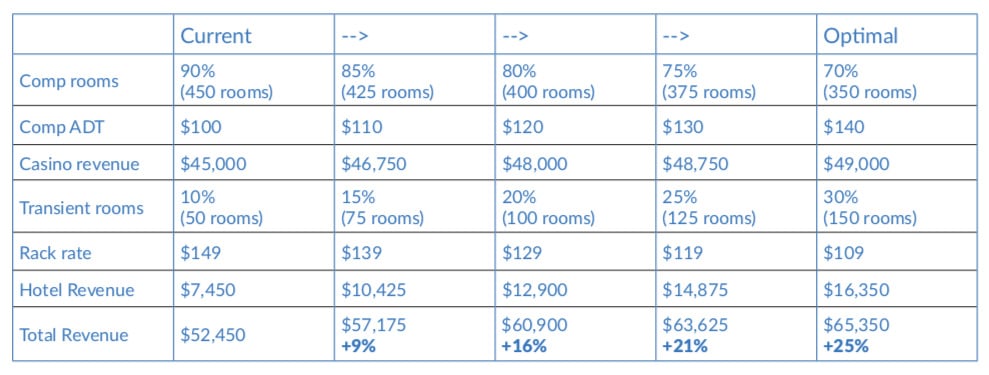Until recently, marketers and casino revenue managers have largely looked past nuanced reinvestment calculations, because the only goal was filling the hotel and, ultimately, the casino.
NB: This is an article from Duetto
Consider the following chart:

These simplified figures show a 500-room casino resort that usually fills 90% of its rooms with non-paying guests, based on their Average Daily Theoretical loss (ADT) from the gaming floor. For the sake of ease, we’ll only consider ADT, not total-customer value that incorporates non-gaming spending.
The numbers in the first column from the left show a typical scenario: The casino sets an ADT of $100 as the threshold to qualify for a comp on this night, and 90% of its patrons are given that free room, leaving only 50 rooms for cash paying customers. To keep comparisons simple, let’s assume that the cash customers don’t gamble at all, and that the comped players only spend up to the ADT threshold in the casino that night.
Assuming the rack rate for the hotel that date is $149, the cash-paying customers produce $7,450 in rooms revenue for the night, while the comped players generate $45,000 in gaming revenue.
Now, work your way from left to right on the chart. Casino revenue managers can yield a few variables, such as setting a higher ADT value as the threshold for a comp, awarding fewer comp rooms to rated players, and charging a lower price on more rooms allotted to cash-paying customers. When you give away fewer rooms, your ADT rises because you can be more selective with which players you comp.
Even if the transient rate on a hotel room decreases by $5 or $10, potentially increasing demand, the casino still captures more rooms revenue. Revenue management helps the casino be more flexible in its pricing and reinvestment while still increasing profitability. As illustrated, the typical scenario yields $52,450 in total revenue (gambling win + rooms revenue) with 90% of rooms comped. But shifting to a mix of 70% comped rooms — with a higher average ADT on the gaming floor and a much lower rack rate in the hotel — can produce a 25% increase in revenue in this example.
Greater Total-Resort Profitability
Reinvestment strategies can be more flexible to meet changing demand. Most casinos have three tiers of pricing:
- A comp for their highest-rated players
- A transient rate for cash-paying customers
- A “casino rate” in between for players or spenders who have value to the casino, just not enough for a full comp.
Adjusting your casino’s reinvestment strategy leads to greater total-resort profitability. As noted above, you can understand more about your guests than just the ADT of your players. Analyze as much data as possible from across the entire property to identify your highest-value guests who generate the most profit for your casino.
Using only your casino database to fill hotel rooms is not the optimal strategy. If you’re basing your reinvestment solely on ADT, you’re missing the bigger picture.
Reinvestment strategies vary greatly from one operation to the next, but many casinos are reinvesting too much into low-rated guests. At properties with little competition, reinvestment could be reduced dramatically. For instance, a Midwest casino located a long drive from its nearest competitor should be spending far less on its patrons than a resort on the Las Vegas Strip, where reinvestment rates might be 30% to 35% of ADT.
A more complex revenue picture means casinos need a more sophisticated reinvestment strategy. Fortunately, new tactics leverage dynamic sources of data to optimize transient room rates according to demand, calculate a total customer worth more holistically than ADT, and choose a reinvestment percentage that reflects that worth to the resort. None of those values needs to be static. Those decisions can be flexible, so your casino can reward every person spending money on property — gambling or otherwise — without treating everybody like a high roller.
The casino rate does not need to be fixed on any night, regardless of the comp threshold or the transient rate. With a dynamic reinvestment strategy, the casino would segment all its potential guests looking for a hotel room for a certain date by total value. That value could just be ADT if the casino is unable to track other kinds of revenue, but ideally, it would include all on-property spending. The casino could then decide to reinvest all of that person’s value and subtract the full amount from the rack rate on a low-demand night, or it could only take a percentage of that value off the rack rate. Because the reinvestment rate could be flexed by any number of segments, an unlimited number of casino rates is possible for a given booking date.
The more price points you have available to meet your demand, the closer you get to capturing the entire opportunity for revenue.





